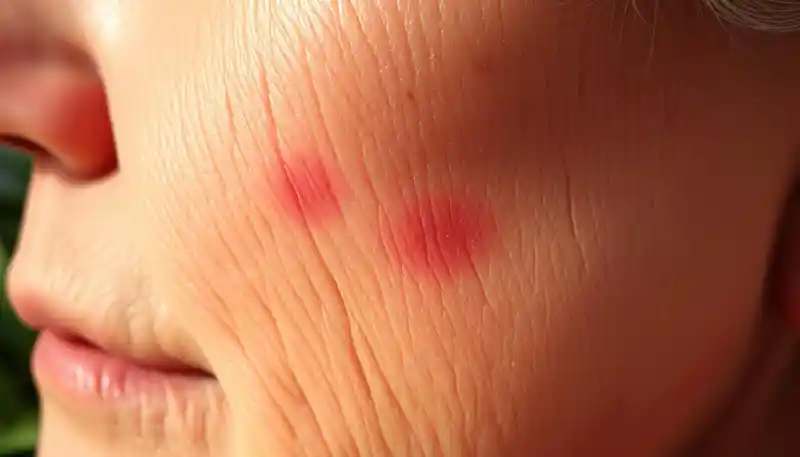Sun exposure causes 90% of visible skin aging. This explains why many adults over 40 struggle with sun spots. These blemishes, also called age spots, can appear on your body and affect your confidence12.
Sun spots often show up on areas exposed to sunlight. They appear as flat, dark patches on your face, hands, shoulders, and arms. People with fair skin are more prone to developing these spots1.
Many adults find themselves dealing with sun spots as they age. It’s common to feel self-conscious about their appearance. But don’t worry, there are solutions available.
Both professional and DIY treatments can help reduce sun spots. Options range from topical creams to natural remedies. Let’s explore how you can address this skin concern and boost your confidence.
Key Takeaways:
- Sun exposure is the primary cause of visible skin aging
- Sun spots commonly appear on sun-exposed areas of the body
- Adults over 40 are more susceptible to developing sun spots
- Both professional and DIY treatments are available for sun spots
- Addressing sun spots can help boost self-confidence
Understanding Sun Spots on Skin: Causes and Risk Factors
Sun spots are small, dark areas that appear on sun-exposed skin. They’re common in adults over 50 and are also called age spots or liver spots.
What are sun spots and how do they form?
Sun spots occur when melanin clumps or is produced in high concentrations. Years of ultraviolet (UV) light exposure3 cause this process. They’re usually harmless but indicate significant sun damage.
Sun spots may increase skin cancer risk4. It’s important to monitor any changes in their appearance.

Common areas affected by sun spots
Sun spots typically appear on areas frequently exposed to the sun. These include:
- Face
- Hands
- Shoulders
- Arms
- Décolletage
These flat, oval areas range from freckle size to about 1/2 inch across35. They’re more noticeable on lighter skin tones.
Risk factors for developing sun spots
Several factors increase your chances of developing sun spots. Understanding these can help with prevention and treatment.
| Risk Factor | Description |
|---|---|
| Age | More common in adults over 40, especially those over 50 |
| Skin type | Fair complexion increases risk |
| Sun exposure | History of frequent or intense sun exposure |
| Genetics | Family history can play a role |
| Hormonal changes | Pregnancy or menopause can contribute |
Mature skin care is crucial for preventing sun damage. Focus on sun protection in your over 40 skincare routine.
Adult skincare practices can help reduce hyperpigmentation35. Regular use of sunscreen is key to preventing new sun spots.
The Emotional Impact of Sun Spots: Dealing with Self-Consciousness
Sun spots can hurt your self-esteem, especially after 40. These skin marks often cause worry about your looks. You might fret over uneven skin tone or wish for younger-looking skin.
The quest for radiant skin can push you to find beauty fixes. Many adults feel ashamed of their sun spots. This can shake their confidence in social settings.
Psychodermatology studies how skin issues affect mental health. Knowing you’re not alone can help tackle both physical and emotional aspects.
Your skin tells your life story. Sun spots remind us of fun times outdoors. Embrace your skin’s journey while seeking treatments that boost your confidence.
With the right approach, you can work towards a youthful look. Don’t let sun spots define your worth678.
FAQ
What causes sun spots to form?
Sun spots form when melanin clumps together. Years of sun exposure boost melanin production. UV light speeds up this process, leading to sun spots.
What are the common areas affected by sun spots?
Sun spots often show up on sun-exposed areas. These include the face, hands, shoulders, and upper back.
Who is at risk of developing sun spots?
Light-skinned people face higher risks. Frequent sun exposure also increases chances. Being over 40 years old is another risk factor.
What is the emotional impact of sun spots?
Sun spots can hurt self-esteem and confidence. They’re visible signs of aging and sun damage. Many feel ashamed or embarrassed about their sun spots.
This can lead to decreased self-worth and social anxiety. Sun spots often make people feel self-conscious about their appearance.
Can sun spots be a sign of skin cancer?
Sun spots aren’t harmful by themselves. But they show significant sun damage. This may increase the risk of skin cancer.
How can I treat or prevent sun spots?
Many options can help fade or remove sun spots. These include DIY skincare, homemade treatments, and brightening serums.
Dark spot correctors can also help maintain even skin tone. Sun protection is key to prevent new sun spots.
Source Links
- Sunspots on face: Causes, treatments, and home remedies – https://www.medicalnewstoday.com/articles/sunspots-on-face
- How to Get Rid of Sun Spots | Causes & Care | NIVEA – https://www.nivea.co.uk/advice/sun/sun-spots
- Sun spots: Causes, treatment & prevention – https://blog.walgreens.com/health/skin-health-conditions/sun-spots-causes-treatment-prevention.html
- Sun spots and skin cancer: Your guide to protection and prevention – https://healthy.kaiserpermanente.org/health-wellness/healtharticle.sun-spot-skin-cancer-know-difference
- Age Spots: Symptoms and Treatment | The Dermatology & Skin Cancer Surgery Center at Creedmoor – https://www.creedmoorskinsurgerycenter.com/conditions/age-spots
- Understanding hyperpigmentation in Latinas: Causes, impacts, and treatments – https://www.hola.com/us/beauty/20240326357865/hyperpigmentation-in-latinas-causes-impacts-and-treatments/
- Dermatologic Symptoms And Diagnosis | Germain Dermatology – https://germaindermatology.com/common-dermatologic-symptoms-and-diagnosis/
- Age Spots/Sun Damage | Neem Medical Spa – https://neemmedicalspa.com/concerns/face/age-spots-sun-damage/






